the place where Paleontology and Paleoanthropology meets Philately
Kenya
Prehistoric animals and humans on stamps of Kenya
| << previous country | back to index | next country >> |
Contents:
- Country overview
- Philately of Kenya
- Official common stamp issues of Kenya, Tanzania, Uganda
- Official stamps of Kenya related to Paleontology
- References
- Acknowledgements
Kenya, officially the Republic of Kenya, is a country in Africa and a founding member of the East African Community (EAC). Kenya has a population of approximately 45 million. Kenya's territory lies on the equator and overlies the East African Rift covering a diverse and expansive terrain that extends roughly from Lake Victoria to Lake Turkana (formerly called Lake Rudolf) and further south-east to the Indian Ocean. It is bordered by Tanzania to the south, Uganda to the west, South Sudan to the north-west, Ethiopia to the north and Somalia to the north-east.
The British Empire established the East Africa Protectorate in 1895, which starting in 1920 gave way to the Kenya Colony. Kenya obtained independence in December 1963. Following a referendum in August 2010 and adoption of a new constitution, Kenya is now divided into 47 semi-autonomous counties, governed by elected governors.
Fossils found in Kenya suggest that primates roamed the area more than 20 million years ago. Recent findings near Lake Turkana indicate that hominids such as Homo habilis (1.8 and 2.5 million years ago) and Homo erectus (1.9 million to 350,000 years ago) are possible direct ancestors of modern Homo sapiens and lived in Kenya in the Pleistocene epoch. During excavations at Lake Turkana in 1984, paleoanthropologist Richard Leakey assisted by Kamoya Kimeu discovered the Turkana Boy, a 1.6-million-year-old fossil belonging to Homo erectus. Previous research on early hominids is particularly identified with Mary Leakey and Louis Leakey, who were responsible for the preliminary archaeological research at Olorgesailie and Hyrax Hill. Later work at the former site was undertaken by Glynn Isaac. [R1]
The first stamps of independent Kenya were issued on 12 December 1963. Before that the territory used the stamps of British East Africa Company (1890-1895), British East Africa (1895-1903), East Africa and Uganda Protectorates (1903-1922), Kenya and Uganda (1922-1935) and Kenya, Uganda and Tanganyika/Tanzania (1935-1976). [R2]
Stamps of British East Africa (Kenya, Tanzania, Uganda) related to Paleontology and Paleoanthropology: reconstruction and fossils of prehistoric animals and humans
| 02.05.1967 "Archaeological Relics of East Africa" [1] | 03.11.1975 "2nd World Black and African Festival of Art and Culture" [2] | |
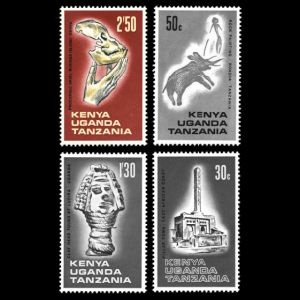 |
 |
|
Official stamps of Kenya related to Paleontology and Paleoanthropology: petrified wood, reconstruction and fossils of prehistoric animals and humans
| 15.01.1977 "2nd World Black and African Festival of Art and Culture" [2] | 31.12.1977 "Minerals", definitive stamp set [3] | 19.01.1982 "Origins of Mankind" |
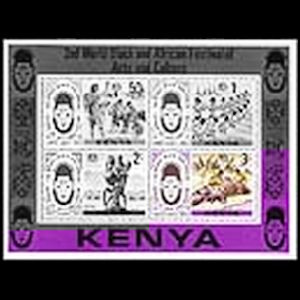 |
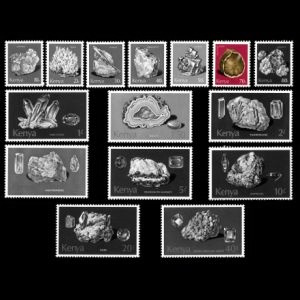 |
 |
Notes:
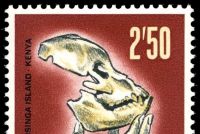
|
| Skull of prehistoric primate Proconsul in stamp of Kenya Tanzania Uganda 1967 MiNr.: 167, Scott: 179 |
Proconsul is an extinct genus of primates that existed from 23 to 25 million years ago during the Miocene epoch. Fossil remains are present in Eastern Africa including Kenya and Uganda. Four species have been classified to date: Proconsul africanus, Proconsul gitongai, Proconsul major and Proconsul meswae. The four species differ mainly in body size. Environmental reconstructions for the Early Miocene Proconsul sites are still tentative and range from forested environments to more open, arid grasslands.
The first specimen, a partial jaw discovered in 1909 by a gold prospector at Koru, near Kisumu in western Kenya, was also the oldest fossil hominoid known until recently, and the first fossil mammal ever found in sub-Saharan Africa. [R3]
[2] "2nd World Black and African Festival of Art and Culture" stamps issued by East-African community of Great Britain: Kenya, Uganda and Tanganyika/Tanzania in 1975 and later on as joint issue of independent countries: Kenya, Tanzania and Uganda in 1977.

|

|
| Stone age primitive men butchering a Hippopotamus on stamps of Kenya Tanzania Uganda 1975 MiNr.:, Scott: | Stone age primitive men butchering a Hippopotamus on stamps of Kenya 1977 MiNr.: 73, Scott: 75 |
Festac'77, also known as the Second World Black and African Festival of Arts and Culture (the first was in Dakar, 1966), was a cultural jamboree held in Lagos, Nigeria, from 15 January 1977 to 12 February 1977.
The month-long event celebrated African culture and showcased to the world African music, fine art, literature, drama, dance and religion.
About 16,000 participants, representing 56 African nation and countries of the African Diaspora, performed at the event. [R4]
Stone age primitive men butchering a Hippopotamus shown on a bottom-right stamp of the mini-sheet.
[3] Silicified/petrified piece of wood shown on a red stamp with face value of 70c.

|
| Piece of petrified wood on stamp of Kenya 1977 MiNr.: 101, Scott: 103 |
Other stamps of Kenya to consider: fossils found places
| 23.11.2002 "Historical Sites of East Africa" [A1] | 11.12.2013 "50th anniversary of independence" [A2] | |
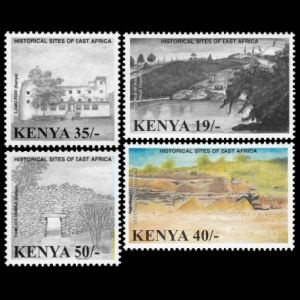 |
 |
|
Notes:

|
| Olduvai gorge site on stamp of Kenya 2002 MiNr.: 765, Scott: 769 |

|
| Turkana Lake on stamp on Kenya 2016 MiNr.:, Scott: |
Olduvai Gorge, or Oldupai Gorge, in Tanzania is one of the most important paleoanthropological sites in the world; it has proven invaluable in furthering understanding of early human evolution. A steep-sided ravine in the Great Rift Valley that stretches across East Africa, it is about 48 km long, and is located in the eastern Serengeti Plains in the Arusha Region not far, about 45 kilometres, from Laetoli, another important archaeological site of early human occupation. The British/Tanzanian paleoanthropologist-archeologist team Mary and Louis Leakey established and developed the excavation and research programs at Olduvai Gorge which achieved great advances of human knowledge and world-renowned status. [R6]
[A2] Kenya issued three sheets of 25 stamps each in 2013 to commemorate the 50th anniversary of Kenya’s independence. These sheets are very rare and expensive. One of the stamps shows Lake Turkana
Lake Turkana, formerly known as Lake Rudolf, is a lake in the Kenyan Rift Valley, in northern Kenya, with its far northern end crossing into Ethiopia. It is the world's largest permanent desert lake and the world's largest alkaline lake. Lake Turkana National Parks are now listed as a UNESCO World Heritage Site. Sibiloi National Park lies on the lake's eastern shore, while Central Island National Park and South Island National Park lie in the lake. Both are known for their Nile crocodiles. In the Lake Turkana area an abundance of hominid fossils was discovered. [R7]
References:
- [R1] Kenya:
Wikipedia,
WikiTravel,
FlagCounter.
- [R2] Postal History and Philately of Kenya:
Wikipedia,
Links to official website of the Post Authority, stamp catalog and a list of new stamps of Kenya are here - [R3] Proconsul: Wikipedia
- [R4] Festac'77, the Second World Black and African Festival of Arts and Culture: Wikipedia
- [R5] Petrified Forest in Sibiloi National Park: safari254
- [R6] Olduvai gorge: Wikipedia
- [R7] Lake Turkana: Wikipedia
Acknowledgements:
Many thanks to Dr. Peter Voice from Department of Geological and Environmental Sciences, Western Michigan University, for reviewing the draft page and his valuable comments.
| << previous country | back to index | next country >> |